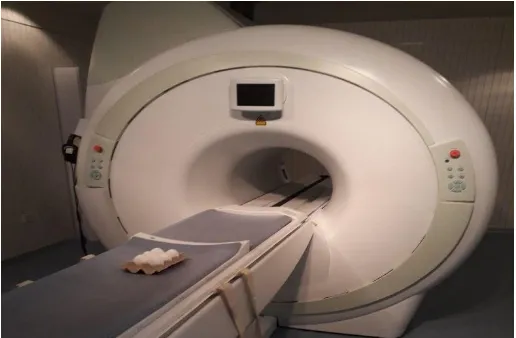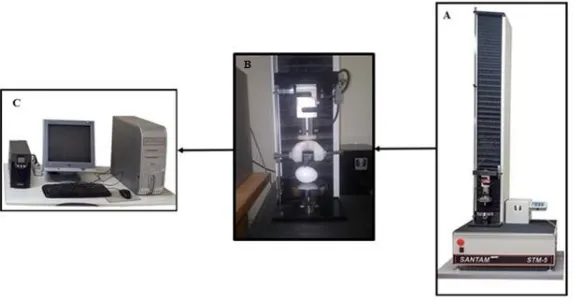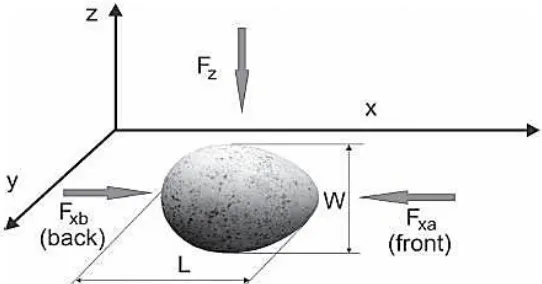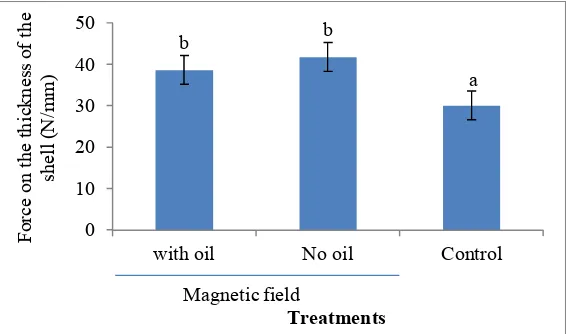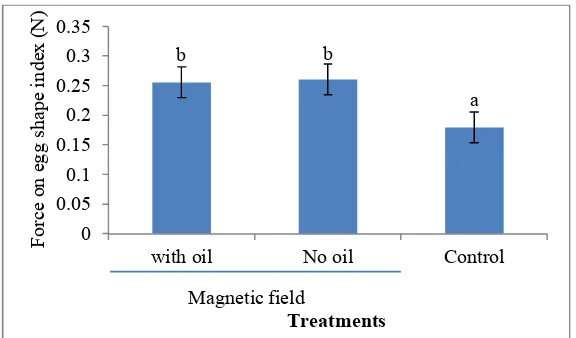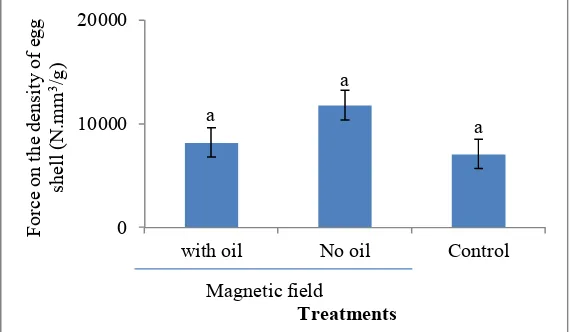ISSN: 2345-6604 (Print), 2345-6566 (Online) http://psj.gau.ac.ir DOI: 10.22069/psj.2019.16316.1412
Investigating the Amount of Resistance to Break the Eggshell Under the Influence
of a Strong Magnetic Field (MRI)
MahmoodiMJ1, Azadbakht M1, AsghariA1 & Dastar B2
1
Department of Bio-System Mechanical Engineering, Faculty of Water and Soil Engineering, Gorgan University of Agricultural Sciences and Natural Resources, Gorgan, Iran
2Department of Animal and Poultry Nutrition, Faculty of Animal Science, Gorgan University of Agricultural Sciences and Natural Resources, Gorgan, Iran
Poultry Science Journal 2019, 7(2): 101-108
Abstract
Keywords
Egg Shell Failure force Magnetic field
Bird eggs should have high internal and external quality to maintain the economic life of the product and hence recognizing and understanding the factors affecting egg quality have great importance. In this experiment, 18 healthy eggs were selected and then exposed to a 1.5 Tesla magnetic field. After this stage, 6 samples of them were immersed in sunflower oil and stored for two days. In the next step, length and width, failure force, thickness and weight of eggshell were measured. Then, the amount of shell density, volume, spherical coefficient, and egg shape index were obtained using the desired formulas. Due to the effect of the calculated parameters on the failure force of eggshells, and in order to remove this effect, the calculated failure force was divided on the calculated parameter. The results of experiment showed that the highest ratio of failure force of eggshell on the parameters was related to the samples placed in the magnetic field and no immersed with sunflower oil. As in all cases was significantly different from control samples. The lowest amount was also attributed to control samples. In general, it was concluded that the presence of samples in the magnetic field increases the shell's resistance to failure, but samples that are immersed in sunflower oil had a lower failure force than those which are not immersed in sunflower oil. Finally, it can be concluded that with the presence of eggs in a high-power magnetic field, we can see an increase in the resistance force to the shell failure.
Corresponding author Mohsen Azadbakht azadbakht@gau.ac.ir
Article history
Received: 15 February, 2019 Revised: 16 June, 2019 Accepted: 29 July, 2019
Introduction
Eggs are one of the cheap but very nutritious foods which the health of the customer is directly related with its quality. Today, due to increased public awareness, the use of eggs as a source of essential amino acids is expanded. Egg quality is complex and its stability in storage, in addition to the chemical composition, includes egg size, the color and the quality of the shell, as well as defects such as the stain of blood and pieces of meat (Abdanan et al., 2014). The egg industry around the world has an excellent quality of internal and external egg production that is essential for its economic life. Egg quality problems are currently causing huge costs in the industry. Therefore, there is a great deal of importance to understanding the factors which affect the internal and external quality of eggs (Roberts,
properties of animal materials are one of the essential requirements for the design and efficient use of used equipment in transportation, processing, packing and storage of agricultural products. In a natural environment, shell eggs should be strong enough to prevent cracking eggs as well as weak enough so that if necessary they can be broken and thin enough to be able to exchange gas and thus maintain its contents. In this context, maintaining the power of the eggshell is necessary to prevent damage and preservation of eggs when moving from farm to market. The egg failure force depends on its different properties, such as specific gravity, weight, volume, surface area and thickness of the egg, shell weight and shell percentage (Ketelaere et al., 2002; Jacob et al., 2011). Egg size and shell thickness are strongly related to each other. As the weight of egg increases during production, eggshell thickness and failure resistance is usually reduced (Harms et al., 1990). The quality of the egg depends on the size and weight of the egg. Egg properties such as shell shape index and thickness affect egg damage during transportation (Anderson et al., 2004). Narushin et al. (2004) found a strong correlation between shell failure force and shell percentage (Narushin et al., 2004). In Carter's research on eggs in 1976, he determined the relationship between shell strength and shape index (Carter, 1976). A number of researchers have examined the physical and mechanical properties of egg and Japanese quail egg by different compression loads. Breaking power as a direct variable to measure the strength of an eggshell is a difficult variable to measure, because only one measurement can be taken from each egg and heavily dependent on the speed of compression. However, there are technical and available data in the references on the mechanical behavior of eggs in different compression directions (Voisey & Hunt, 1969; Ketelaere et al., 2002; Lin et al., 2004; Narushin et al., 2004).
So far, little researches have has been carried out
on the effects of the magnetic field on the properties and behavior of the agricultural products as well as the physical, mechanical and biochemical properties of the eggs. In similar cases, the effects of the magnetic field on the growth of different plants have been evaluated. For example, Rio & Rio (2013) in research, it has been determined that the magnetic field causes faster growth of the olive plant. So that it has a positive effect on the height, length, diameter, weight, and the number of fruits in the olive bush and it can make it heavier and larger (Rio & Rio, 2013). Also, the magnetic field has had a positive effect on the growth of okra. It has reduced the incidence of pests and insects (Rio & Rio, 2013).
The purpose of this experiment was to investigate some of the physical and mechanical properties of eggs, under the influence of magnetic field and storage conditions. These features include dimensions, weight, volume, spherical coefficient, eggshell thickness, shape index, and breaking force of the eggshell.
Materials and Methods
Sample preparation and selection of treatments 18 healthy eggs were collected from an egg layer flock (Hyline W36 strain with 30 weeks of age) in a private company near the city of Gorgan, Golestan province, on October 13, 2018, and then transferred to Gorgan University of Agricultural Sciences and Natural Resources, Gorgan, Iran. 12 eggs were placed in a magnetic field for 13 minutes, with 1.5 Tesla strength and then divided into two groups of immersed and non-immersed sunflower oil while the six rest eggs was kept without any treatments as control. In order to impregnate eggs, the oil was poured into a sack and smeared with cotton at the same rate. Sunflower oil was used due to its positive effect on durability and preservation of egg quality. Then the samples were stored for two days and the physical and mechanical properties were measured.
Magnetic field
The magnetic resonance imaging (MRI) device (Alltech Echostar 1.5 T, Made in China) was utilized to apply a magnetic field to the samples. The MRI system consists of a magnet to create a strong magnetic field, send and receive coils of radio frequency, magnetic field gradients, a computer system, and accessories (Figure 1). 12 samples were exposed to a magnetic resonance imaging device to apply the desired magnetic field. The Transverse axis of the eggs was aligned with the longitudinal axis (z) of the magnetic field. Cardboard boxes were used to hold eggs during the process of stacking in the magnetic field.
Physical characteristics of the eggs
After placement eggs in a magnetic field, half of the samples were impregnated with sunflower oil and then stored for two days. Then, the length (L) and width (W) of the eggs were measured using an electronic digital caliper with a precision of 0.01 mm. Volume (V), spherical coefficient (ø) and Shape index (SI) were calculated using Equations 1 to 3.
) ( 6
2
LW
V (Equation 1; Mohsenin,
1986)
100 * ] / )
[( 3
1 2
L LW
(Equation 2; Polat 2007) et al.,
100 * ) / (W L
SI (Equation 3; Altuntaş & Şekeroǧlu, 2008)
Where:
L: Length (mm), W: Width (mm), Dg: Geometric diameter (mm), V: Volume (mm3), Ø: Spherical coefficient (%), SI: Form index (%).
The eggshell thickness determined using an electronic digital caliper with a precision of 0.01 mm. Eggshell density (SD) was calculated using Equations 4.
ST S
SW SD
*
Equation 4; Curtis et al.,
1985) (
Where: SD: Eggshell density (g.cm-3), SW: Eggshell weight (g), S: Surface area (mm2), ST: Eggshell thickness (mm).
Quasi-static edge test
The required failure force of eggshells under quasi-static loading was investigated in three cases of impregnated specimens without impurities in sunflower oil under the magnetic field and control. Quasi-static loading indicates sample resistance to failure, so the extracted data is suitable for investigating the effect of magnetic field and impurity on sunflower oil.
For thin edge quasi-static testing was performed using an Indestron (Santam-STM5) device with a load of 500 N strain for the pressure test, the thin edge of a plastic jaw was considered with a surface of 3×15 mm (Figure 2). In order to increase the accuracy of the measurement, the speed of the device when applying the pressure force was 0.33 mm/min, in the direction of the z-axis (Figure 3) and in three replications was performed, and as a result failure force of the eggshell was obtained. Loading was continued until the egg shell’s failure, and then the force-extension diagram was drawn up by Instron and its data was extracted. The eggshell breaking force is determined by the force-deformation curve. So that in the shell breaking force, there is a large change in the force in the curve (Galić et al., 2017).
Figure 2. The quasi-static loading diagram of the egg.
A: Force-diformation device (Indestrone); B: Eggs arrangement; C: Computer.
Statistical analysis
Data were analyzed in a completely randomized design with SAS statistical software. Breaking force of eggs after 2 day storage was considered as resistance in breaking, while breaking force of the
Figure 3. A schematic view of the physical characteristics of the egg, for the input of different forces. L: Length, W:Width, Fxa, Fxb: Force along the x-axis, Fz: Force along the z-axis.
Results and Discussion
The results of the analysis of variance of the variables studied include control samples and magnetic fields (impregnated and not impregnated with oil) on the amount of eggshell breaking force. According to the
results obtained in this table, it can be concluded that the studied variables have a significant effect on the ratio of breaking force to the shell thickness, volume and spike coefficient of egg, and in the rest of the cases, no significant changes were observed.
Table 1. Effects of impregnated and non-impregnated variables on eggshell oil in a magnetic field on the amount
of eggshell breaking force.
Variable DF Mean Squares F value
The failure force ratio to eggshell weight 2 0.4791 7.09**
The failure force ratio to eggshell thickness 2 193.9777 9.19**
The ratio of failure force to egg volume 2 0.0093 14.63**
The ratio of failure force to the egg spherical coefficient 2 0.0046 3.11ns
The failure force ratio to the egg shape index 2 0.0106 4.01*
the failure force ratio on the eggshell density 2 33867942.38 2.48ns **Indicates a significant difference at 5% level; * Indicates a significant difference at 1% level; ns indicates no significant difference.
Investigation of the failure force ratio to eggshell weight
Figure 4 shows the effect of different pre-treatments on the ratio of failure force on eggshell weight. Divide the amount of failure force by the eggshell weight can be attributed to the difference in shell weight of each sample and its possible effect on the amount of eggshell failure force. In fact, the effect of the difference in the shell weight on different samples is eliminated, and results can be verified with high confidence. According to the results, pre-treatment of the magnetic field has the highest ratio of failure force to eggshell weight. Also, the lowest value of the calculated ratio was for control samples. In the membrane, the eggs placed in the magnetic field will penetrate more water, thereby further exchanging water and carbon dioxide. Therefore, they have more airbag area and volume. Considering the correlation between the area or volume of egg airbags with the resistance to shell defects, the reason for this observation can be stated as follows (Nematinia et al., 2017). Due to the lack of effect of storage time on eggshell weight in similar studies, it can be concluded that the observed changes in eggshell failure force
were due to the effect of a strong magnetic field on it (Nematinia et al., 2017).
Investigation of the failure force ratio to eggshell thickness
Figure 4. The effect of different pre-treatments on the ratio of failure force to eggshell weight. The same letters indicate no significant difference (P < 0.05).
Figure 5. The effect of different pre-treatments on the ratio of the failure force ratio to eggshell thickness.
The same letters indicate no significant difference (P < 0.05).
Investigating of the ratio of failure force to egg volume
The effect of different magnetic field pre-treatments on the ratio of failure force to egg volume is shown in Fig. 6. As in the previous cases, due to the effect of measured parameters in determining the amount of its failure force, the failure force ratio was calculated on total egg volume. According to the results, the control samples with the lowest amount of 0.1293 and the samples of the magnetic field without impregnation with sunflower oil with a value of 0.2255 have the highest amount of failure force per egg volume. The reason for this observation can be attributed to the positive correlation between the volume of egg airbags and the resistance to failure of the shell. Egg bags placed in the magnetic field have the potential to absorb more ions, especially Ca+2, and this increases the exchange capacity of water and carbon dioxide in the egg bag and thus increases the resistance to break egg shells (Kumagai et al., 1978). Due to the lack of similar work with this research, it can be concluded that observing the changes in the eggshell defect due
to the presence in the magnetic field can rely on the results of researches on the positive effect of the magnetic field on the plants agreed (Rio & Rio, 2013).
Investigating the ratio of failure force to the egg spherical coefficient
Figure 7 shows the effect of different magnetic field pre-treatments on the value of the failure force ratio to the eggshell spherical coefficient. Considering the effect of the spherical coefficient to the failure force and the necessity of eliminating this effect in the calculations, the ratio between failure force and spherical coefficient was calculated and shown in the graphs. According to the obtained results, the pre-treatment of the magnetic field has the highest ratio of eggshell failure force to the egg spherical coefficient. Also, the lowest value of the calculated ratio was for the control samples. Increasing the absorption power of Ca+2 ions due to the presence of egg samples in the magnetic field, resulting in a greater exchange of water and carbon dioxide that
b b
a
0 0.5 1 1.5 2 2.5 3
with oil No oil Control
F
o
rc
e
o
n
she
ll
w
ei
g
ht
(
N
/g
)
Magnetic field
Treatments
b b
a
0 10 20 30 40 50
with oil No oil Control
F
o
rc
e
o
n
t
h
e
th
ic
kn
es
s
o
f
th
e
sh
el
l
(N
/m
m
)
Magnetic field
causes an increase in the volume of a contained airbag in the egg. This increase in the volume of egg internal airbag is justified by other studies about the effects of magnetic fields on plants. Now considering
the direct relationship between the volume of the inner airbag and the resistance to breaking of the eggshell, the reason for this observation can be explained as follows (Selim & El-nady, 2011).
Figure 6. The effect of different pre-treatments on the ratio of failure force of eggshell to egg volume.
The same letters indicate no significant difference (P < 0.05).
Figure 7. The effect of different pre-treatments on the ratio of failure force of eggshell to egg spherical coefficient.
The same letters indicate no significant difference (P < 0.05).
Figure 8. The effect of different pre-treatments on the ratio of failure force of eggshell on the egg shape index.
The same letters indicate no significant difference (P < 0.05).
b b
a
0 0.05 0.1 0.15 0.2 0.25 0.3
with oil No oil Control
F
o
rc
e
o
n
e
gg
v
o
lum
e
(N
/m
m
3)
Magnetic field
Treatments
ab
b
a
0 0.05 0.1 0.15 0.2
with oil No oil Control
T
h
e
fo
rc
e
o
n
t
h
e
egg
sph
er
ic
co
ef
fi
ci
en
t
(N
)
Magnetic field
Treatments
b b
a
0 0.05 0.1 0.15 0.2 0.25 0.3 0.35
with oil No oil Control
F
o
rc
e
o
n
e
gg
sh
ape
i
n
de
x
(N
)
Magnetic field
Investigation of the failure force ratio to the egg shape index
In Figure 8, the effect of different magnetic field pre-treatments on the amount of shell failure force ratio to the egg shape index is shown. According to the results, the control samples have the least amount of calculated ratio, and the magnetic field samples,
without impregnating with oil, have the highest fracture strength ratio on the eggshell shape index. These results are considered as positive results for increasing the strength of eggshell against failure, which can be attributed to the increase of water and carbon dioxide power exchange in eggs (Nematinia et al., 2017).
Figure 9. The effect of different pre-treatments on the ratio of failure force on eggshell density.
The same letters indicate no significant difference (P < 0.05).
Investigation of the failure force ratio on the eggshell density
The numerical value of the effect of different pre-treatments on the ratio of the failure force on the eggshell density is shown in Figure 9. Due to the possible effect of eggshell density on the amount of failure force, a proportion of them is calculated to prevent its effect on the conclusion and dispersion of the quantities. According to the results, the pre-treatment of the magnetic field has the highest and the control samples have the least value of the failure force ratio to the eggshell density. An increase in the internal airbag contents of located eggs in the magnetic field and the direct relationship between the volume of the airbag and the size of the eggshell
failure force leads to this justification (Nematinia et al., 2017).
Conclusions
It was observed that samples under the magnetic field have the highest ratio of force to the measured parameters compared to the control samples. Also, non-impregnated sunflower oil samples showed higher resistance to oil impregnated specimens than shell breaking. In general, it can be concluded that the application of the magnetic field increases the resistance to breaking the shell relative to the samples without a presence in the magnetic field after two day storage time.
References
Abdanan S, Minaei S, Hancock NH & Torshizi MAK. 2014. An intelligent system for egg quality classification based on visible-infrared transmittance spectroscopy. Information Processing in Agriculture. 1: 105–114. DOI: 0.1016/j.inpa.2014.10.002
Altuntaş E & Şekeroǧlu A. 2008. Effect of egg shape index on mechanical properties of chicken eggs. Journal of Food Engineering. 85: 606–612. DOI: 10.1016/j.jfoodeng.2007.08.022
Anderson KE, Tharrington JB & Curtis PA. 2004. Shell characteristics of eggs from historic strains of single comb white leghorn chickens and the relationship of egg shape to shell strength. International Journal of poultry science. 3: 17–19. DOI: 10.3923/ijps.2004.17.19
Carter TC. 1976. The hen’s EGG: Shell forces at impact and quasi‐static compression. British Poultry Science. 17: 199–214. DOI: 10.1080/00071667608416267
Coucke P, Jacobs G, Sas P & De Baerdemaeker J. 1999. Comparative analysis of the static and dynamic mechanical eggshell behaviour of a chicken egg, in: Proceedings o the international seminar on modal analysis. pp. 1497–1502.
Curtis PA, Gardner FA & Mellor DB. 1985. A Comparison of Selected Quality and Compositional Characteristics of Brown and White Shell Eggs: I. Shell Quality. Poultry Science. 64: 297–301. DOI: 10.3382/ps.0640297
Cutts JA, Wilson GC & Fernández S. 2007. Optimum egg quality: a practical approach. 5M Publishing. a
a
a
0 10000 20000
with oil No oil Control
F
o
rc
e
o
n
t
h
e
de
n
si
ty
o
f
egg
sh
el
l
(N
.m
m
3/g)
Magnetic field
De Ketelaere B, Govaerts T, Coucke P, Dewil E, Visscher J, Decuypere E & De Baerdemaeker J. 2002. Measuring the eggshell strength of 6 different genetic strains of laying hens: techniques and comparisons. Brazilian Journal of Poultry Science. 43: 238–244. DOI: 10.1080/00071660120121454 Galić A, Pliestić S, Janječić Z, Bedeković D, Filipović
D, Kovačev I & Čopec K. 2017. Some Physical, Morphological and Mechanical Characteristics of Turkey (Meleagris gallopavo) Eggs. Brazilian Journal of Poultry Science. 20: 317–324. DOI: 10.1590/1806-9061-2017-0679
Harms RH, Rossi AF, Sloan DR, Miles RD & Christmas RB. 1990. A method for estimating shell weight and correcting specific gravity for egg weight in eggshell quality studies. Poultry Science. 69: 48– 52. DOI: 10.3382/ps.0690048
Jacob JP, Miles RD & Mather FB. 2011. Egg Quality 1. Kumagai N, Sasajima S & Ito H. 1978. Long-term creep
of rocks (results with large specimens obtained in about 20 years and those with small specimens in about 3 years). Journal of the Society of Materials Science. 27: 155–161. DOI: 10.2472/jsms.27.155 Lin H, Mertens K, Kemps B, Govaerts T, De Ketelaere
B, De Baerdemaeker J, Decuypere E & Buyse, J. 2004. New approach of testing the effect of heat stress on eggshell quality: mechanical and material properties of eggshell and membrane. British Poultry Science. 45:476–482. DOI: 10.1080/00071660400001173
Mohsenin NN. 1986. Physical characteristics of plant and animal materials, Physical characteristics and mechanical characteristics. Gordon Breach Sci Publ, New York.
Narushin VG, Van Kempen TA, Wineland MJ & Christensen VL. 2004. Comparing infrared spectroscopy and egg size measurements for predicting eggshell quality. Biosystems Engineering.
87: 367–373. DOI:
10.1016/j.biosystemseng.2003.12.006
Nematinia E, Mehdizadeh SA & Ghorbani MR. 2017. Classification of Eggs Based on the Internal Quality Using of Computer Vision. (persian).
Polat R, Tarhan S, Çetin M & Atay U. 2007. Mechanical behaviour under compression loading and some physical parameters of japanese quail (Coturnix coturnix japonica) eggs. Czech Journal of Animal Science. 52: 50–56. DOI: 10.17221/2262-cjas
Rio LC & Rio MM. 2013. Effect of Electro-Magnetic Field on the Growth Characteristicsof Okra (Abelmoschus esculentus), Tomato (Solanum Lycopersicum) And Eggplant (Solanum Melongena). International Journal of Scientific and Research Publications. 3.
Roberts JR. 2004. Factors Affecting Egg Internal Quality and Egg Shell Quality in Laying Hens. Journal Poultry Science. 41: 161–177. DOI: 10.2141/jpsa.41.161
Selim AH & El-nady MF. 2011. Acta Astronautica Physio-anatomical responses of drought stressed tomato plants to magnetic field. Acta Astronaut. 69: 387–396. DOI: 10.1016/j.actaastro.2011.05.025 Voisey PW & Hunt JR. 1969. Effect of compression
